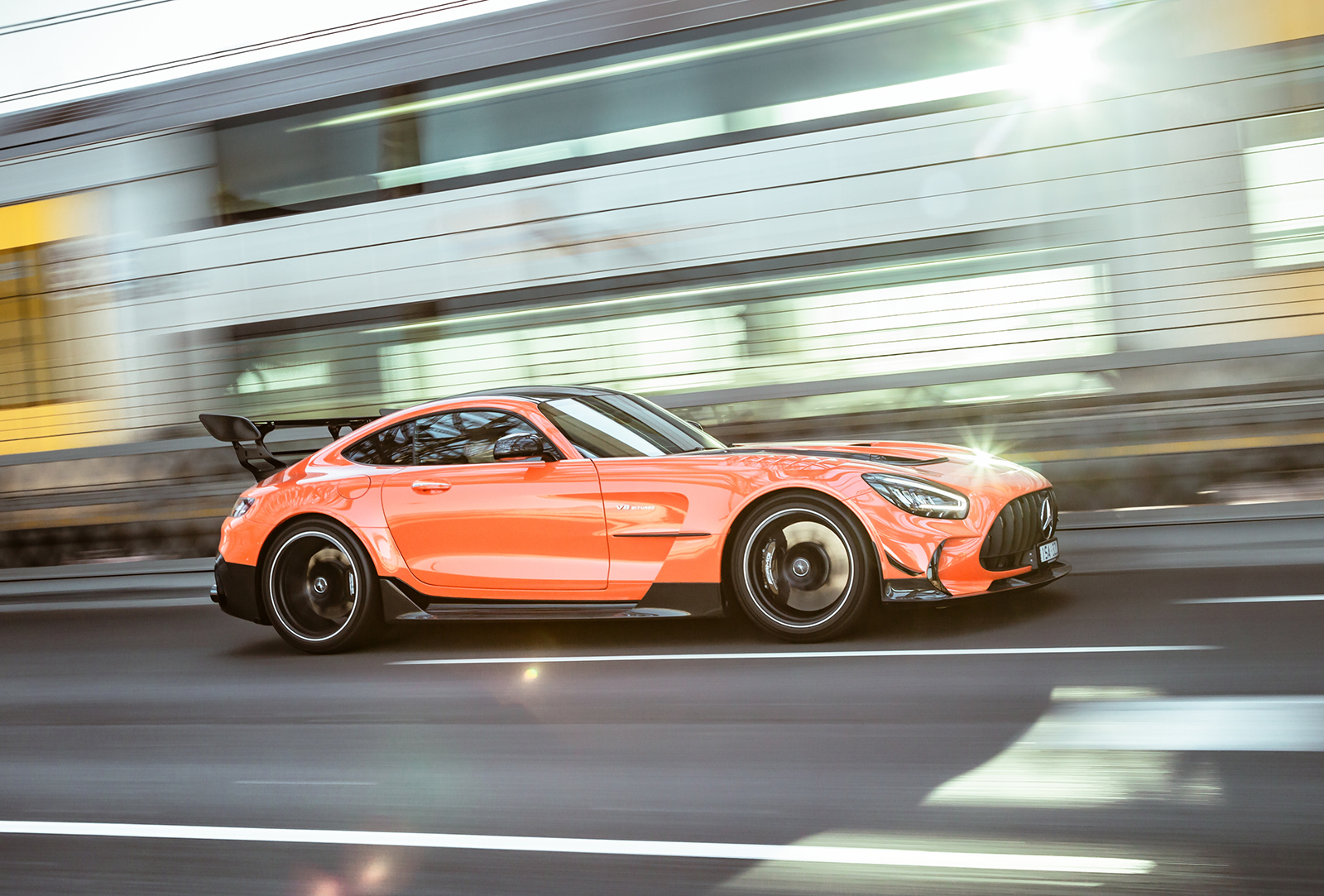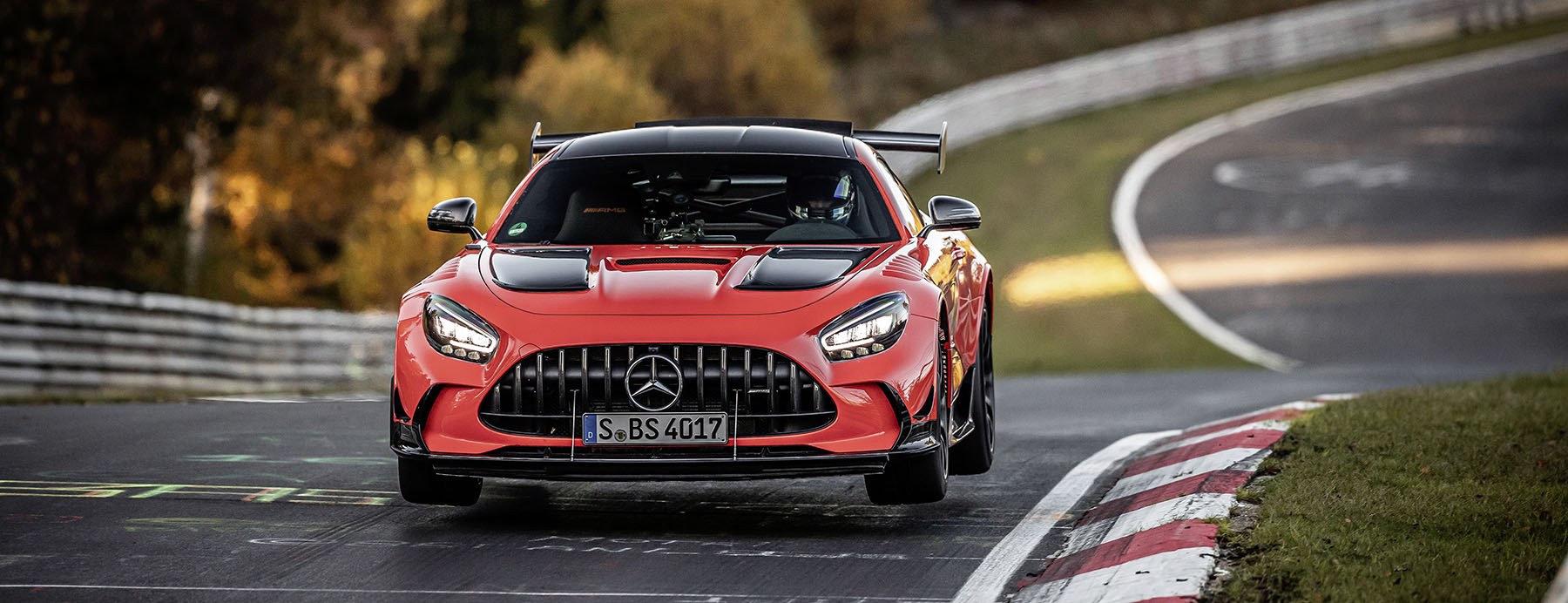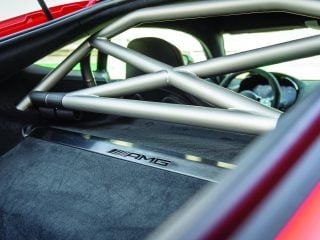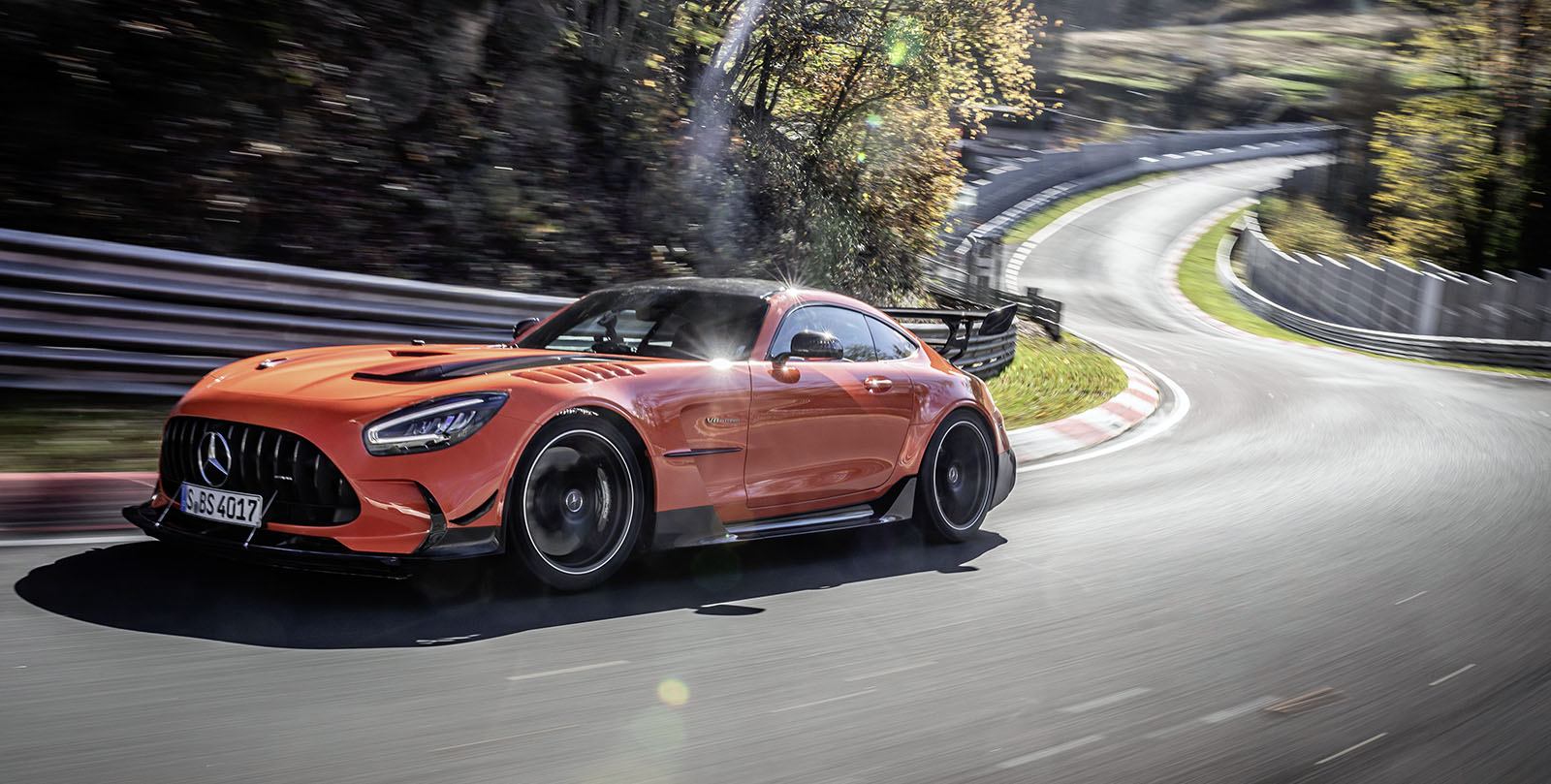As only the sixth model to wear AMG’s most exclusive badge, the GT Black Series has big shoes to fill. But with a 537kW twin-turbocharged V8 and a record-breaking resume, the most hardcore Mercedes-AMG model ever delivers.
ORANGE IS THE NEW BLACK
Words by Jesse Taylor
Photography by Thomas Wielecki
SYDNEY IS DEEP INTO lockdown and 2021 has ground to a halt across much of the nation. I’ve not driven a car for months, I’ve walked the dog on the same loop morning and night for what feels like forever and home-schooling has descended into a farce – Fornite is part of the curriculum, right? Ground Hog Day doesn’t even begin to cover it. And then I get a text from Todd the truckie.
“Be at your place in 15.” The minutes drag by but eventually the rhythmic beep of a reversing truck serenades me out of my house and into the crisp early Spring morning. In a flurry of cheery professionalism, Todd reverses the Mercedes-AMG GT Black Series out of its cocoon and on to my street to the smiles of my children and the gasps of neighbours. Jaws drop further when I explain that once on-road costs have been added to the $796,900 base price, the Black Series before them is the best part of a million dollars. A Magma Beam Orange dose of vitamin C has been delivered to lift my street from its pallid dullness. Monotony has been banished and the hours of Covid-related paperwork to make this drive and photoshoot happen is instantly worth it.
I circle the outrageous shape, ostensibly checking for damage before I sign any paperwork, but mainly trying to drink in the ducts and vents and jutting splitter. And that wing! Aside from the last couple of months, my son and daughter have never known a period without press cars in their life (many of them from the performance of luxury end of the market), but they are gobsmacked by the Black Series. I’ve driven AMG’s GT3 race car and the Black Series looks like it requires only the addition of a roundel on the door and the deletion of the number plates to line up on the same grid. It just looks so far beyond what’s legal for a road car.
It’s a thought that never leaves me over the next two days, and each time I return to the Black Series or catch its reflection in a shop window, I’m stunned that I’ve not been given a breach of the peace notice for daring to even park it in public. Given the Covid restrictions that are in place, I’m half expecting the Public Order and Riot Squad to descend on me and the Black Series at any moment.
Todd’s left the AMG running for me as he readies his truck for departure, so I’m robbed of a cold start. Instead, I realise that the 4.0-litre twin-turbocharged V8’s busy idle is at odds with the menacing looks. AMGs usually bellow and burble at idle, but the use of a flatplane crank instead of the cross-plane crank in every other iteration of AMG’s M177 and M178 4.0-litre twinturbo V8 gives the Black Series a tighter, lighter note. Ferrari V8s have long used a flat-plane crank, but the Black Series is different again to the screaming note of engines from Maranello. There’s a whirring busyness to the idle but also a hint of uneven cammy throb. It’s only later, during my first exploratory surge through the mid-range and towards the 7200rpm red line that it clicks. The Black Series’ V8 sounds like two 1000cc sports bikes accelerating ever so slightly out of unison. And don’t think that’s a criticism. As the revs build, the engine loses that slight unevenness that’s evident at idle and low rpm, switching to a sewing-machine smooth purr.
If the engine note is at odds with the Black Series’ Darth Maul aesthetic, the surge of performance when the taps are opened is both expected and shocking. With very little build up, the engine delivers explosive performance that feels bigger than the numbers suggest. A 325km/h top speed, 0-100km/h in 3.2 seconds and 0-200km/h in “under nine” are outrageous claims, but the Black Series feels even more unhinged.
With 537kW available from 6700-6900rpm, the Black Series’ LS2 variant of the dry-sumped M178 produces an astonishing 107kW more power than that of the AMG GT R. Then there’s the not so small matter of 800Nm available from just 2000 all the way around the tacho to 6000rpm. That massive torque plateau suggests that the engine is like so many other heavily turbocharged engines – one dimensional.
Instead, the Black Series’ LS2 isn’t a mid-range monster but is much closer in character to Ferrari’s turbocharged V8s that have powered the 488 and F8 variants since the demise of the naturally aspirated engine in the 458. The AMG engine is linear and expressive, and like the Ferrari engines, builds to a proper crescendo, rather than fizzling out like so many turbocharged engines. In fact, the V8 is so smooth and (relatively) quiet, that you expect that you’ve at least another 1000rpm to play with when you arrive at the 7200rpm red line. Also like the Ferrari engines, the throttle response of the Black’s V8 gets sharper as the revs rise. Given the numbers involved, and the 1.7 bar of boost filling the Borg Warner turbochargers, the clarity of response from the throttle is astounding and just what you need when you’re trying to meter out power and torque to those vast rear Michelin Pilot Sport Cup 2 tyres (that measure a comical 335/30 ZR20).
Despite the illegality of the Black Series’ looks and the promise of lap records every time you wheel it out of the garage, it makes for a surprisingly civilised companion, allowing you to enjoy it as a road car and not just suffer on the journey to and from a circuit. With the adjustable dampers in comfort mode, the ride is nicely polished somewhat lulling you away from the adrenaline spike that is the exterior. But your attention soon snaps back when you glance in the rear-view mirror through the sturdy roll cage and under the rear wing to what might be following behind – unless the red and blues are lit, you’ve little chance to tell what that might be. The dash and centre console are familiar from the AMG GT R, but the cage and the low and lock-downed seating position feels more akin to the brand’s GT4 and GT3 race cars. You feel right at the centre of the action.
Flashes of orange bodywork are just visible from the driver’s seat, but you know that there’s vast acreage of bonnet out of sight. As with all AMG GT variants, you feel like you’re on top of the back axle, exaggerating how quickly the front end snaps left or right to the command of the fast steering. But like in Ferrari’s 812 Superfast, it takes just a few minutes to reconcile your inputs to the reactions of the Black Series’ steering, and smooth natural progress ensures thereafter.
Civilised though the Black Series can be, Mr Hyde is lurking just below the surface and cold Michelin Pilot Sport Cup 2 tyres struggle to manage 537kW and, especially, 800Nm. A firm run through second and into third has the rear stepping out of line, but with the ESC and traction control in its most conservate (default) setting, the Black Series is quick to jump on any misbehaviour. Later, I swallow a brave pill, switch off the ESC and have a brief play with the motorsport-style traction control system. I venture as far as extinguishing all of the red lights, leaving just the three yellow lights illuminated on the nine-stage system. It’s more than enough for the Black Series to signal that I’m in charge and that it will only now provide a guiding rather than helping hand. It’s also enough to show that the electronics aren’t hiding anything that the chassis isn’t trying to tell you with everything switched on. It’d take more time and a circuit to fully confirm, but despite the prodigious outputs, the Black Series feels transparent and on your side. Of course, a Nürburgring lap record for production cars doesn’t happen by accident.
Hardcore track cars are very much my thing, and my all-time top 10 features only a couple of cars that don’t claim to be circuit refugees. And yes, the list includes both the GT Black Series and the legendary SLS Black. But some may baulk at the $796,900 list price of the new Black, and even I admit to whistling through my teeth when I first learnt of the number. After all, the Mercedes-AMG GT range begins at sub-$300K and the GT R Pro only asked $453,200. Excluding special order unicorns such as the McLaren Elva and Pagani Huayra, the GT Black Series is at the very top of the Australian new car market. It sits just below the $846,888 Ferrari SF90 (to which you can add a $111K Assetto Fiorano option for track work) and the $949,640 Lamborghini Aventador SVJ. Given that the Black Series usurped the Lamborghini as the fastest production car around the Nürburgring (see more on page 88), you could argue that the AMG is something of a bargain. Debate over the price is moot anyway, with the Australian allocation of 28 already snapped up – though one surfaced online during our time with this Black Series with an asking price of $1.5 million.
Mercedes-AMG hasn’t specified the number of GT Black Series that will be built, saying only that the model will be built for a year from October 2020 – though Covid delays might extend that marginally. As you can read on page 94, Black Series variants are ultra rare with just 2270 built across the five models prior to the GT. With 800 examples built, the C63 Black Series is the most numerous, so you can surmise that only a few hundred GT Blacks will roll off the line in Affalterbach.
Hopefully they aren’t all bought by speculators because there’s something very special about the Black Series. The opportunity to drive one for a few days is a real shot in the arm for me, lifting me out of a lockdown malaise. And not just me. Every time the 537kW ray of sunshine pulls to a kerb, iPhones are whipped out of their holsters and polite questions asked. And it’s not just the usual suspects of young men, but literally everyone from a young mum pushing a pram, to several older men and women, some of whom make the effort to leave their homes and cross the street to chat – not something I anticipated during lockdown.
I can’t recall a car that’s drawn such attention, and all positive, during a photoshoot. Usually there’s a Karen who wants to speak to my manager, or who threatens to call the police for the breaking of a rule that they’ve made up. But everyone loves the Black Series.
Two interactions are of particular note and both have a nice Mercedes back story. The first begins with an elderly lady staring out the window while on the phone. When she comes out and marches towards me, I’m assuming that she’s going to inform me that she’s called the police for being too orange. Instead, she asks if we’d mind waiting while she fetches her husband so he can have a closer look at the car. No problem.
A few minutes later, Scottish John arrives and, while he’s admiring the engine of the Black Series, casually tells us that he was employed as a civil engineer by Daimler back in the 1950s and early ’60s, working on various factory upgrades in Stuttgart. He tells us of the shock, even as a young Scot, of the Germans drinking steins of lager at work and of walking through the skunkworks department, past the Mille Miglia-winning 300 SLR of Stirling Moss and Denis Jenkinson. Oh, and he met and chatted with both Moss and Jenkinson on numerous occasions.
Later, while positioning the Black Series for a shot overlooking the harbour, I see the curtain twitch in an upstairs room of a waterfront home. The middle-aged woman waves a cheery hello as I jump out of frame for Thomas and shouts down that her partner has one in yellow, but without “all the fancy wings”. Five minutes later and to illustrate the point, she opens both garage doors to reveal an AMG GT S and a C63 Estate. Then she wants to know all about the Black Series.
Automotive Daily’s evo ‘thrill of driving tag line’ is always evident in everything that we do, but it’s moments like these – especially during times like these – that prove cars such as the AMG GT Black Series are so much more than a collection of numbers or a means to get from A to B. Just as they did when we first got our licences, cars still represent the idea of freedom. And just as they did when the genre first appeared over 50 years ago, supercars such as the GT Black Series still have the power to make everyone feel like a little kid again.
2021 Mercedes-AMG GT Black Series
Engine 3982cc twin-turbo V8, Variable DOHC per bank, 32-valve, electronic fuel injection and engine management Power 537kW @ 6700rpm Torque 800Nm @ 2000rpm Transmission Seven-speed dual clutch automatic, rear-wheel drive, limited-slip differential Steering Rack and pinion, power-assisted Suspension Front and rear: independent double wishbones, multi link, adjustable dampers, adjustable spring pre-load, adjustable anti-roll bar stiffness Brakes Discs, ABS Weight 1540kg Top speed 325kph 0-100kph 3.2sec
DARK MATTER
Theoretically, the 537kW Black Series sits at the pinnacle of the GT range, but with such a raft of changes it actually stands apart as its own model.
WAY BACK IN 2014 AT THE LAUNCH of the AMG GT at Laguna Seca, then Mercedes-AMG CEO Tobias Moers, let me know that eventually, a production version of the GT would breach the 500kW barrier. This seemed like an enormous leap over the 375kW GT S variant that we were driving, but Moers has always been a straight shooter, and we’d developed a close relationship over the years, so there was no reason to doubt him.
“This is only the beginning,” he’d said, gesturing at the Edition One GT S I’d just sampled. Quizzed further, he’d only smile at my summation that the monster engine would power a Black Series variant, but he did suggest that the ultimate number would be around 530kW.
And here we are with the 537kW, AMG GT Black Series. Like so many AMG products, it makes sense to start with the engine. It’s known as the LS2, and while maybe the Detroit reference is German humour to throw spies off the scent during the development of this M178 derivative, it’s far from a pushrod bent-eight in the nose of a Camaro. Consider it a thorough reinvention of the ubiquitous V8, switching from a cross-plane crankshaft to a flat-plane one, so out goes the traditional rumble and in comes the higher-pitched, harder timbre of a duophonic four-cylinder with added range and bite.
For this final and ultimate AMG GT, the engineers wanted more power. ‘Don’t they always,’ you might say, and power is hardly something that the M178 has been known for lacking in the past. But to hit a 500kW-plus target they needed to run serious levels of boost – 1.7 bar, as it turns out – and the objective was revs: that hard-edged, aggressive top end that would allow the GT to stand nose-canard-to-nose-canard with the Longtail McLarens, Special Series Ferraris and force-fed GT department Porsches of this world.
The subsequently improved gas flow and the lighter crank assembly contribute to an engine that lacks the smoothness and sometimes the low-down torque of a rumbly, cross-plane V8, but one that typically has a greater appetite for revs. It’s a bold project from Affalterbach, especially for just this one car, and the engine feels unlike anything else in the performance car realm. It’s genuine special and more than a little bit motorsport.
You won’t be surprised to hear that much of the engine’s hardware has been redesigned. The turbochargers themselves are bigger, with the low-friction bearings used on the mighty GT63 S 4-Door Coupe also used here, while there are bigger intercoolers and completely new exhaust manifolds and camshafts. The result? 537kW from 6700 to 6900rpm, and 800Nm from just 2000rpm all the way to 6000rpm.
The Black Series is a lot more than just its engine, however. The 430kW GT R is a terrific thing: a driver-focused supercar with its own individual appeal. The GT R Pro took that evolution a stage further, adding a GT3 RS-threatening trackday vibe and scooping 2nd overall in the 2019 edition of eCoty. It was a big car with a massive heart, but also one that communicated clearly: sometimes that was to say ‘watch yourself mate’, but such correspondence between driver and machine made it far less intimidating on the limit than anything with its looks has any right to be. But the Black doesn’t even attract the GT R moniker: it’s simply GT Black Series. A model apart.
The AMG engineers have worked hard to increase the rigidity of the chassis, an imperative given the mechanical grip and aerodynamic load now generated by the car. There are carbon shear panels at the front, centre and rear, and a lightweight front subframe carbon transmission tunnel brace. Naturally they’ve sought to shave off every last gram where possible. You’ll find carbonfibre everywhere, from the front adjustable anti-roll bars to the new bonnet with its enormous extractor holes. The roof and tailgate are also now made of the stuff, while there’s lightweight glazing and all sorts of lightened minor componentry. As the engineers confided to us a while back, save making fundamental and unrealistically expensive changes to the inherent structure of the car, there’s really no way they could have gone much lower than the Black’s quoted 1520kg kerb weight (41kg lighter than the Pro).
but the rear wing is something else again: two tiers with a section of the upper wing adjustable by up to 20 degrees via the electronic driving modes, depending on speed, driving style and any given corner.
Coupled with an almost completely flat underside, the Black’s aero qualities are considerable. And you don’t need numbers to know that; the sturdy rear wing supports that are located through the boot floor are testimony to just how much load is generated at high speed.
And clearly all of the technical changes work, with AMG GT3 racer Maro Engel hustling the Black Series around the Nürburgring in 6:43.616. At the time, August 2020, this lap knocked Lamborghini’s Aventador SVJ off the top spot as world’s fastest production car. The lap time has subsequently been pipped by a Manthay Racing-tweaked Porsche 911 GT2 RS, with the distinction being that the GT2 RS MR is listed as the world’s fastest road-legal car at the Nordschleife, while the AMG GT Black Series is the world’s fastest production car around the Ring.
BLACK TO BLACK
HE MERCEDES-AMG GT BLACK Series is only the sixth model to wear the badge and the first since the 2013 SLS Black Series. The badge has never been applied to anything other than a two-door model, and prior to the release of the ultimate GT, Mercedes-AMG has built just 2270 Black Series models. For some perspective, Porsche built 1000 examples of its 991.2 GT2 RS during its 18-month run. Unless I’ve been fortunate enough to be driving one, I’ve only ever seen a Black Series on the road once – RS Porsches are rare, but a Black Series is a needle in a haystack.
The Black Series journey started in 2006 with the SLK 55 (top right), with the model built on the 35-unit limited edition Tracksport. The SLK 55 Black Series was powered by a naturally aspirated 5.4-litre V8 producing 295kW, enough to give the fixed-head coupe version of the SLK a 280km/h top speed. With just 120 units produced, the SLK 55 is the rarest of all Blacks.
The CLK 63 Black Series (top left) followed in 2007, and again used a naturally aspirated V8, this time the 6208cc M158, while the CLK DTM used the older supercharged 5.4-litre V8. Demand for the CLK 63 Black Series pushed AMG to build 700 units.
The following year, the SL65 Black Series (middle right) debuted with a 493kW twin-turbocharged 6.0-litre V12 and wild bodywork. Until the arrival of the GT Black Series, the SL65 Black was the most powerful Mercedes- AMG product with an ICE. It remains the only Black Series not to use a V8 and was the first turbocharged Black – the latter distinction since matched by the new GT. Just 300 were built.
With 800 units produced, the C63 Coupe Black Series (red car) of 2011 is the most numerous Black model. The plan had been to build 600 units of the 6.2-litre, 380kW C-Class, but demand twisted AMG’s arm for an additional 200.
The SLS Black Series (yellow car) of 2013 was the first of the bloodline to truly feel like a race car – a characteristic that the new GT Black has embraced and wound right up. We first sampled the SLS Black at the wild west Willow Springs race track in the Californian desert and it felt like part GT3 racer and part V8 Supercar. Its 464kW 6208cc M159 V8 dominated, but the iron-fisted body control and vast grip extracted the best from the engine. We pounded around Willow Spring for at least 80 laps and then had a sneaky 326km/h vmax run through the desert. Only 350 examples of this legend were built.
OPENING LAP
Automotive Daily’s evo celebrates the new GT Black Series by recalling the SLS Roadster that launched our journey.
PRINT IS DEAD. IT’LL LAST THREE ISSUES. The newsstand is already too crowded. These were just some of the words of encouragement that evo Australia received from within the publishing and automotive industries when we announced that we were launching back in 2013. But not from Mercedes-Benz.
When we first mentioned our plan to the local arm of Mercedes-Benz, management enthusiastically promised support. Plucking up the courage to ask whether they’d supply a car for a proposed lap of Australia for the launch issue cover story, a brand new SLS Roadster (not the existing press car) was offered within 13 minutes of me sending the email. It’s worth noting that at the time, the SLS Roadster listed at $487,000 but the example we were offered was nudging $600,000 by the time it sat on the road.
Six weeks later, photographer Thomas Wielecki and I departed Melbourne in a box-fresh SLS Roadster showing just 1011 run-in kilometres on the odometer. Seventeen days later, it would return to Melbourne having added 18,734km.
I remember being tempted to run up and down the Hume for a couple of hours to tick over the 20,000km mark. At the time, a hot shower and comfy bed won the day, but eight and half years later, those missing 255km still bother me.
The plan had been a simple one; drive a lap of Australia sticking to Highway One and slapping on bumper stickers along the way. Then we added side trips to the farthest points of the compass that sealed roads would take us – in the west, that was within metres of the cliffs overlooking the Indian Ocean at Point Quuba. Of course, we couldn’t resist adding three days and thousands of kilometres to the trip by diving into the heart of the country to stand in awe before Ulura and Kata Tjuta. In 2021, that freedom of movement seems like a dream.
More than 1000km of roadworks marred the run up the east coast, and days stretched into tomorrow. Despite 6am departures, days two and three had us arriving at our destinations at 1- and 2am the next day. Once across the Great Dividing Range, the trip found its rhythm and the SLS Roadster was always an entertaining companion.
As major centres receded in the mirror, it was a pleasure to share such an exotic sports car with people more used to seeing LandCruisers and campervans. The excitement on the faces of young First Nations children was humbling, as was the interaction with an Elder in Halls Creek who studied the bumper stickers marking our travels. “You’ve been all through my country,” he began as tears welled in his eyes. “I’ve not been to many places in years. I probably won’t ever.”
As we lined up waiting our turn to drive onto Broome’s famed Cable Beach, onlookers warned of the cost of a tow, but their jeers turned to cheers as the mighty SLS Roadster made several passes along the beach and through the soft sand back to the tarmac.
We ran out of fuel 28km short of Mount Isa at just after midnight, we saw car crashes, a derailed freight train, waded through flash flooding and raised help for French backpackers whose van had blown a head gasket 200km from anywhere. We ate some serious dodgy food and slept in even dodgier motels, but the trip was golden and the perfect launch to evo Australia.
[adning id=”102004″]


























































